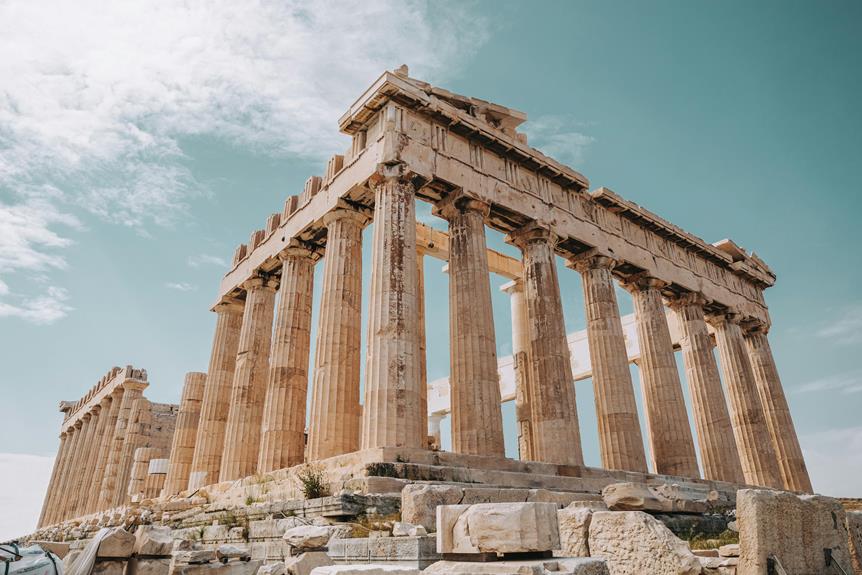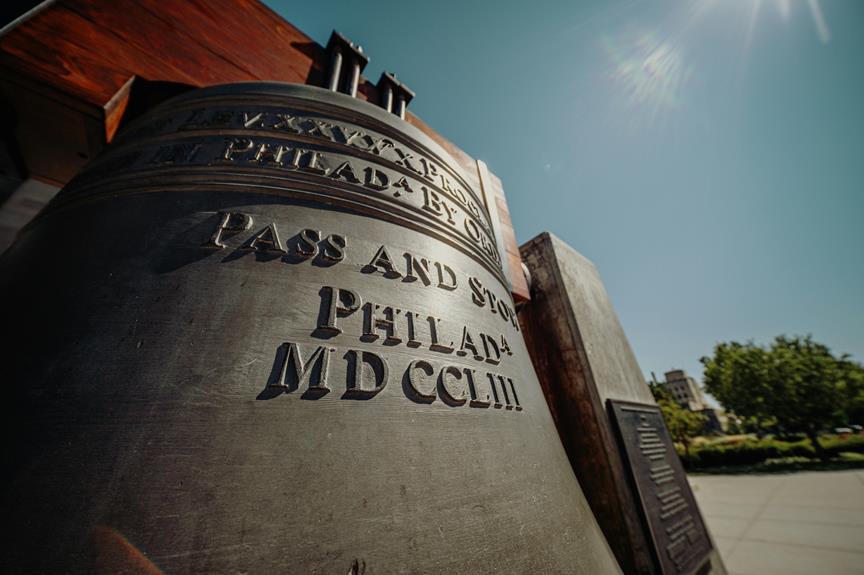The Cenotaph in the UK stands as a solemn sentinel of remembrance, embodying the collective memory of sacrifice and valor. Its stoic presence in the heart of London beckons reflection on the profound significance of honoring those who gave their lives in service to their country. As a focal point for national ceremonies and events, the Cenotaph's enduring symbolism resonates deeply with visitors from around the world. Beyond its physical form lies a narrative of resilience and unity that transcends time, inviting contemplation on the lasting impact of honoring the fallen.
Key Takeaways
- Established post-World War I to honor fallen soldiers.
- Designed by Sir Edwin Lutyens with symbolic features.
- Central London location as a national emblem.
- Annual Remembrance Sunday service with royal family.
- Represents collective memory, resilience, and unity.
History of the Cenotaph
The establishment of the Cenotaph in the UK can be traced back to the aftermath of World War I, marking a significant point in the nation's commemorative landscape. Its origins lie in the aftermath of the Great War, where the need to honor and remember the fallen soldiers became paramount. The idea for a national monument to commemorate the sacrifices made during the war began to take shape as a way to provide a focal point for remembrance and reflection.
Over time, the Cenotaph has evolved from being a temporary structure to becoming a permanent symbol of remembrance and reverence. Originally constructed in wood and plaster for the Victory Parade in 1919, its design by Sir Edwin Lutyens was so well-received that a decision was made to rebuild it in stone. The permanent Portland stone monument was revealed on Whitehall in 1920 and has since become the central focus of national ceremonies on days such as Remembrance Sunday.
The evolution of the Cenotaph reflects the changing attitudes towards remembrance and the significance of honoring those who made the ultimate sacrifice. Its simple yet powerful design continues to serve as a poignant reminder of the cost of war and the importance of never forgetting the fallen.
Design and Architecture
Having emerged as a prominent symbol of remembrance following its evolution from a temporary structure, the design and architecture of the Cenotaph in the UK embody a profound sense of solemnity and reverence. The Cenotaph, designed by Sir Edwin Lutyens, features a simple yet powerful design that resonates with visitors. The monument is primarily made of Portland stone and stands at a height of 35 feet. Its minimalist approach is a key design element that symbolizes the purity of remembrance and sacrifice.
Architecturally, the Cenotaph's shape is that of a pylon, tapering towards the top, which is adorned with a simple recumbent laurel wreath. This architectural feature adds to the monument's grandeur and significance. The inscription 'The Glorious Dead' is inscribed on one side, further emphasizing the purpose of the structure.
The Cenotaph's location in Whitehall, London, surrounded by government buildings and near the Houses of Parliament, enhances its impact, creating a solemn atmosphere for commemoration and reflection. The monument's symmetrical design and clean lines contribute to its timeless appeal and make it a focal point during national ceremonies such as Remembrance Sunday.
Significance and Symbolism
In exploring the profound significance and symbolism of the Cenotaph in the UK, one is confronted with a monument that transcends mere physical form to embody a collective memory of sacrifice and honor. The Cenotaph stands as a symbol of utmost importance, representing not only the lives lost in war but also the resilience and unity of a nation in times of adversity. It serves as a focal point for remembrance, a tangible reminder of the sacrifices made by countless individuals in defense of freedom and peace.
The design and placement of the Cenotaph add layers of symbolism to its significance. Located in the heart of London, it occupies a central position both geographically and symbolically, underscoring its role as a national emblem of remembrance. The simplicity of its design, devoid of any specific references to rank, nationality, or victory, further emphasizes its universal message of honoring all those who have fallen in service.
Every year, the Cenotaph becomes the focal point of national ceremonies and events, drawing people from all walks of life to pay their respects. Its stark yet dignified presence evokes a sense of solemnity and reflection, reminding observers of the enduring importance of remembrance in shaping collective memory and honoring the legacy of those who made the ultimate sacrifice.
National Ceremonies and Events
National ceremonies and events centered around the Cenotaph in the UK serve as poignant reminders of the nation's collective gratitude and respect for those who have served and sacrificed in times of conflict. These ceremonial traditions hold deep historical significance and are meticulously planned to honor the sacrifices of the armed forces. One of the most notable events is the Remembrance Sunday service, held annually on the closest Sunday to November 11th, marking the end of World War I. During this solemn occasion, wreaths are laid at the Cenotaph by members of the royal family, political leaders, military personnel, and representatives of the Commonwealth countries.
In addition to Remembrance Sunday, other national ceremonies and events take place throughout the year to pay tribute to the fallen. These events often include military parades, minute's silences, and readings of poignant war poetry. The Cenotaph stands as a focal point for these commemorative tributes, symbolizing the nation's enduring gratitude and remembrance.
The meticulous organization of these events underscores the importance of honoring the sacrifices made by generations past. The ceremonial traditions surrounding the Cenotaph serve as a reminder of the debt owed to those who gave their lives in service of their country, ensuring that their memory lives on in the hearts of the nation.
Restoration and Conservation Efforts
The preservation and upkeep of the Cenotaph in the UK have been paramount in ensuring its historical significance and solemnity are maintained for future generations. Preservation techniques employed include regular cleaning to prevent the accumulation of dirt and pollutants that can degrade the structure over time. Additionally, the use of appropriate materials for any restoration work is essential to maintain the authenticity of the monument while ensuring its longevity and sustainability.
Sustainability is a key consideration in conservation efforts, with a focus on minimizing the environmental impact of any maintenance work. This involves using eco-friendly materials and techniques wherever possible to reduce the carbon footprint associated with the preservation of the Cenotaph.
Public engagement and community involvement play an important role in the restoration and conservation of the Cenotaph. Awareness campaigns, educational programs, and volunteer opportunities not only raise funds for ongoing maintenance but also foster a sense of ownership and pride among the public. By involving the community in the preservation efforts, the Cenotaph becomes more than a monument; it becomes a symbol of collective memory and national identity, ensuring its legacy for generations to come.
Visitor Experience and Accessibility
Enhancing the overall visitor experience and ensuring accessibility to the Cenotaph are integral aspects of its significance as a cultural heritage site. The ability for all individuals to engage with and appreciate the historical and symbolic importance of the Cenotaph is vital for its continued relevance and impact. Accessibility improvements and taking into account visitor feedback are key components in achieving this goal.
Accessibility and Visitor Experience Enhancements:
- Improved Signage: Clear and informative signage around the Cenotaph can provide visitors with historical context and help them navigate the site effectively.
- Multilingual Resources: Offering information in multiple languages can cater to a diverse range of visitors, including international tourists, enhancing their understanding and connection to the site.
- Audio Guides: Implementing audio guides can offer a more immersive experience, providing visitors with detailed explanations and narratives about the significance of the Cenotaph.
- Wheelchair Accessibility: Ensuring wheelchair accessibility and pathways for individuals with mobility challenges is essential to make the site inclusive and welcoming to all.
These enhancements, guided by visitor feedback and a commitment to accessibility, can elevate the overall experience of those who visit the Cenotaph, fostering a deeper appreciation for its historical and cultural importance.
Future of the Cenotaph
Considering the evolving landscape of historical preservation and public engagement, the trajectory of the Cenotaph's future holds significant implications for its continued relevance and impact. As society progresses, the role of impactful memorials like the Cenotaph in honoring the past while resonating with contemporary audiences becomes increasingly crucial. To guarantee its enduring significance, modern adaptations may be necessary to maintain the Cenotaph as a symbol of remembrance and reflection.
The future of the Cenotaph could involve technological advancements to enhance visitor experiences and promote greater accessibility. Virtual reality tours, interactive displays, or augmented reality applications could provide visitors with a deeper understanding of the historical context and significance of the monument. These modern adaptations can help bridge the gap between past sacrifices and present generations, fostering a sense of connection and appreciation for the sacrifices made.
Moreover, the future of the Cenotaph may also involve expanding its educational outreach programs to engage younger audiences and promote a deeper understanding of the monument's importance. By incorporating innovative educational initiatives, such as workshops, lectures, or digital resources, the Cenotaph can remain a relevant and impactful memorial for years to come.
Frequently Asked Questions
Can Visitors Leave Personal Tributes or Items at the Cenotaph?
When considering tribute etiquette and visitor mementos at a memorial site, it is important to recognize the significance of honoring the memory and sacrifice of those being commemorated.
While personal tributes and items can provide a sense of connection and remembrance, it is vital to adhere to any guidelines or regulations set by the memorial site to guarantee the sanctity and respect of the space for all visitors.
Are There Any Hidden or Secret Features of the Cenotaph?
When exploring architectural details of significant monuments, hidden symbols often reveal themselves, adding layers of historical significance and cultural impact.
These concealed features can offer insight into the intentions of the designers and the deeper meaning behind the structure.
Uncovering these elements can provide a new perspective on familiar landmarks, enriching the visitor's experience and fostering a deeper appreciation for the monument's historical and cultural value.
How Often Is the Cenotaph Cleaned or Maintained?
The importance of cleaning and maintenance of historical monuments is vital for their preservation. Preservation techniques often involve a delicate balance between cleaning to remove dirt and grime without causing damage to the structure.
Regular cleaning schedules are typically based on factors such as material composition, exposure to environmental elements, and historical significance. Proper maintenance guarantees that these monuments are preserved for future generations to appreciate and learn from.
Are There Any Myths or Legends Associated With the Cenotaph?
Historical significance often gives rise to folklore tales, adding layers of mystery and intrigue to revered monuments. Symbolic meaning and cultural beliefs can intertwine with these myths, creating a rich tapestry of stories surrounding significant landmarks.
For example, the Great Wall of China is steeped in myths of supernatural origins and the spirits of deceased workers haunting its walls. Such folklore adds depth to the historical importance of these iconic structures.
Can the Public Access the Cenotaph at Any Time of Day?
Public access to the Cenotaph is subject to specific hours, respecting the solemnity of the site. Visitors can pay their respects during designated times, adhering to the established Cenotaph etiquette.
Tributes left by visitors are a common sight, adding to the reverence of the place. Understanding and adhering to these guidelines guarantees that the public can access and honor the Cenotaph appropriately.
Conclusion
To sum up, the Cenotaph in the UK stands as a timeless symbol of remembrance and honor for the sacrifices of fallen soldiers.
With its rich history, profound symbolism, and ongoing restoration efforts, the Cenotaph continues to serve as a solemn reminder of the resilience and unity of the nation.
As we look towards the future, the Cenotaph remains a cornerstone of national identity, embodying the collective memory of those who gave their lives for their country.


